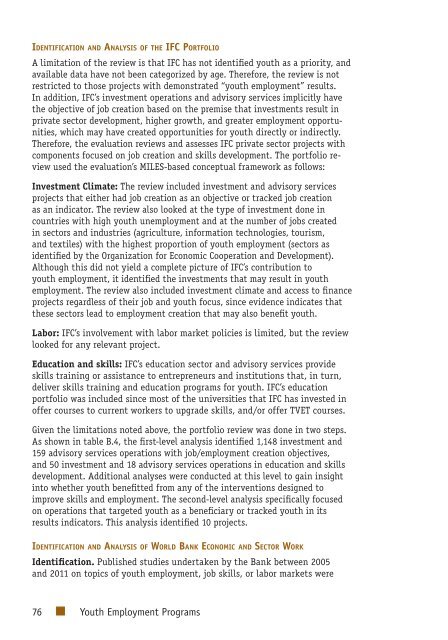Youth Employment Programs - Independent Evaluation Group
Youth Employment Programs - Independent Evaluation Group
Youth Employment Programs - Independent Evaluation Group
Create successful ePaper yourself
Turn your PDF publications into a flip-book with our unique Google optimized e-Paper software.
Identification and Analysis of the IFC PortfolioA limitation of the review is that IFC has not identified youth as a priority, andavailable data have not been categorized by age. Therefore, the review is notrestricted to those projects with demonstrated “youth employment” results.In addition, IFC’s investment operations and advisory services implicitly havethe objective of job creation based on the premise that investments result inprivate sector development, higher growth, and greater employment opportunities,which may have created opportunities for youth directly or indirectly.Therefore, the evaluation reviews and assesses IFC private sector projects withcomponents focused on job creation and skills development. The portfolio reviewused the evaluation’s MILES-based conceptual framework as follows:Investment Climate: The review included investment and advisory servicesprojects that either had job creation as an objective or tracked job creationas an indicator. The review also looked at the type of investment done incountries with high youth unemployment and at the number of jobs createdin sectors and industries (agriculture, information technologies, tourism,and textiles) with the highest proportion of youth employment (sectors asidentified by the Organization for Economic Cooperation and Development).Although this did not yield a complete picture of IFC’s contribution toyouth employment, it identified the investments that may result in youthemployment. The review also included investment climate and access to financeprojects regardless of their job and youth focus, since evidence indicates thatthese sectors lead to employment creation that may also benefit youth.Labor: IFC’s involvement with labor market policies is limited, but the reviewlooked for any relevant project.Education and skills: IFC’s education sector and advisory services provideskills training or assistance to entrepreneurs and institutions that, in turn,deliver skills training and education programs for youth. IFC’s educationportfolio was included since most of the universities that IFC has invested inoffer courses to current workers to upgrade skills, and/or offer TVET courses.Given the limitations noted above, the portfolio review was done in two steps.As shown in table B.4, the first-level analysis identified 1,148 investment and159 advisory services operations with job/employment creation objectives,and 50 investment and 18 advisory services operations in education and skillsdevelopment. Additional analyses were conducted at this level to gain insightinto whether youth benefitted from any of the interventions designed toimprove skills and employment. The second-level analysis specifically focusedon operations that targeted youth as a beneficiary or tracked youth in itsresults indicators. This analysis identified 10 projects.Identification and Analysis of World Bank Economic and Sector WorkIdentification. Published studies undertaken by the Bank between 2005and 2011 on topics of youth employment, job skills, or labor markets were76 <strong>Youth</strong> <strong>Employment</strong> <strong>Programs</strong>
















